
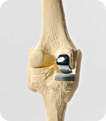
Do I need a knee replacement? In a healthy knee, the ends of your thigh and shin bones are covered with hard cartilage which allows the bones to move easily against each other. Arthritis damages the hard cartilage so that it becomes thin. In places the cartilage may wear away so that your bones rub against each other and become worn. In a knee replacement operation, the worn ends of the bones and any remaining hard cartilage are removed and replaced with metal and plastic parts. The plastic acts like hard cartilage, helping your joint to move freely. The interlocking parts of the artificial joint allow your knee to bend while also making it more stable. You won’t necessarily need a knee replacement if you have arthritis of the knee. But it may be worth considering if your knee is damaged by arthritis and the pain, disability or stiffness are having serious effects on your daily activities. Even then, your healthcare team will always try other measures before suggesting a knee replacement, including drug treatments, physiotherapy and weight loss. If your symptoms are still manageable and your medication is effective then you may prefer to wait. Orthopaedic surgeon will be able to advise you on the surgical options and on the potential pros and cons of having or delaying surgery, taking into account your age, health and level of activity. Most people who have a knee replacement are over 60 years of age. The younger you are when you have surgery, the greater the chance that you’ll need repeat operations. If you’re under 50 and decide to have surgery, then you’re more likely to need a repeat operation in later life. However, there’s evidence that the outcome may be better if you don’t wait until your knee becomes very stiff or deformed.
read more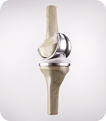
Some people may need a more complex type of knee replacement. The usual reasons for this are: major bone loss due to arthritis or fracture major deformity of the knee weakness of the main knee ligaments. These knee replacements usually feature a longer stem, which allows the component to be more securely fixed into the bone cavity. The components may also interlock in the centre of the knee to form a hinge that stops the joint sliding apart and dislocating. Extra pieces of metal and/or plastic may be used to make up for any removed or badly damaged bone. This type of operation could be advised if you have very severe arthritis or if you’re having revision surgery (a second or third jont replacement in the same knee).
read more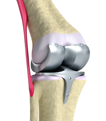
Complex Primary Knee Replacement A total knee replacement is a surgical procedure whereby the diseased knee joint is replaced with artificial material. The knee is a hinge joint which provides motion at the point where the thigh meets the lower leg. The thighbone (or femur) abuts the large bone of the lower leg (tibia) at the knee joint. During a total knee replacement, the end of the femur bone is removed and replaced with a metal shell. The end of the lower leg bone (tibia) is also removed and replaced with a channeled plastic piece with a metal stem. Depending on the condition of the kneecap portion of the knee joint, a plastic “button” may also be added under the kneecap surface. The artificial components of a total knee replacement are referred to as the prosthesis. The posterior cruciate ligament is a tissue that normally stabilizes each side of the knee joint so that the lower leg cannot slide backward in relation to the thighbone. In total knee replacement surgery, this ligament is either retained, sacrificed, or substituted by a polyethylene post. Each of these various designs of total knee replacement has its own particular benefits and risks. What patients should consider a total knee replacement? Total knee replacement surgery is considered for patients whose knee joints have been damaged by either progressive arthritis, trauma, or other rare destructive diseases of the joint. The most common reason for knee replacement in the United States is severe osteoarthritis of the knees. Regardless of the cause of the damage to the joint, the resulting progressively increasing pain and stiffness and decreasing daily function lead the patient to consider total knee replacement. Decisions regarding whether or when to undergo knee replacement surgery are not easy. Patients should understand the risks as well as the benefits before making these decisions
read more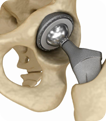
Introduction A hip replacement is a common type of surgery where a damaged hip joint is replaced with an artificial one (known as a prosthesis). The hips The hip joint is one of the largest joints in the human body and is what is known as a “ball and socket joint”. In a healthy hip joint, the bones are connected to each other with bands of tissue known as ligaments. These ligaments are lubricated with fluid to reduce friction. Joints are also surrounded by a type of tissue called cartilage that is designed to help support the joints and prevent bones from rubbing against each other. The main purpose of the hip joints is to support the upper body when a person is standing, walking and running, and to help with certain movements, such as bending and stretching. Why do I need a hip replacement? It might be necessary for you to have a hip replacement if one (or both) of your hip joints becomes damaged and causes you persistent pain or problems with everyday activities such as walking, driving and getting dressed. Some common reasons why a hip joint can become damaged include: osteoarthritis – so-called “wear and tear arthritis”, where the cartilage inside a hip joint becomes worn away, leading to the bones rubbing against each other rheumatoid arthritis – this is caused by the immune system (the body’s defence against infection) mistakenly attacking the lining of the joint, resulting in pain and stiffness hip fracture – if a hip joint becomes severely damaged during a fall or similar accident it may be necessary to replace it Many of the conditions treated with a hip replacement are age-related so hip replacements are usually carried out in older adults aged between 60 and 80. However, a hip replacement may occasionally be performed in younger people. The purpose of a new hip joint is to: relieve pain improve the function of your hip improve your ability to move around improve your quality of life What happens during hip replacement surgery? A hip replacement can be carried out under a general anaesthetic (where you are asleep during the procedure) or an epidural (where the lower body is numbed). The surgeon makes an incision into the hip, removes the damaged hip joint and then replaces it with an artificial joint that is a metal alloy or, in some cases, ceramic. The surgery usually takes around 60-90 minutes to complete. Recovering from hip replacement surgery For the first four to six weeks after the operation you will need a walking aid, such as crutches, to help support you. You may also be enrolled on an exercise programme that is designed to help you regain and then improve the use of your new hip joint. Most people are able to resume normal activities within two to three months but it can take up to a year before you experience the full benefits of your new hip. What to expect after a hip replacement Since its…
read more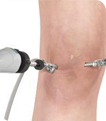
Knee Arthroscopy Arthroscopy is a common surgical procedure in which a joint (arthro-) is viewed (-scopy) using a small camera. Arthroscopy gives doctors a clear view of the inside of the knee. This helps them diagnose and treat knee problems. Technical advances have led to high definition monitors and high resolution cameras. These and other improvements have made arthroscopy a very effective tool for treating knee problems. Description Arthroscopy is done through small incisions. During the procedure, your orthopaedic surgeon inserts the arthroscope (a small camera instrument about the size of a pencil) into your knee joint. The arthroscope sends the image to a television monitor. On the monitor, your surgeon can see the structures of the knee in great detail. Your surgeon can use arthroscopy to feel, repair or remove damaged tissue. To do this, small surgical instruments are inserted through other incisions around your knee. Preparing for Surgery Arthroscopic picture of torn anterior cruciate ligament [yellow star]. If you decide to have knee arthroscopy, you may need a complete physical examination with your family physician before surgery. He or she will assess your health and identify any problems that could interfere with your surgery. Before surgery, tell your orthopaedic surgeon about any medications or supplements that you take. He or she will tell you which medicines you must stop taking before surgery. To help plan your procedure, your orthopaedic surgeon may order pre-operative tests. These may include blood counts or an EKG (electrocardiogram). Surgery Almost all arthroscopic knee surgery is done on an outpatient basis. Arrival Your hospital or surgery center will contact you with specific details about your appointment. You will likely be asked to arrive at the hospital an hour or two before your surgery. Do not eat or drink anything after midnight the night before your surgery. Anesthesia When you first arrive for surgery, a member of the anesthesia team will talk with you. Arthroscopy can be performed under local, regional, or general anesthesia. Local anesthesia numbs just your knee Regional anesthesia numbs you below your waist General anesthesia puts you to sleep The anesthesiologist will help you decide which method would be best for you. If you have local or regional anesthesia, you may be able to watch the procedure on a television monitor. Procedure The orthopaedic surgeon will make a few small incisions in your knee. A sterile solution will be used to fill the knee joint and rinse away any cloudy fluid. This helps your orthopaedic surgeon see your knee clearly and in great detail. surgeon’s first task is to properly diagnose your problem. He or she will insert the arthroscope and use the image projected on the screen to guide it. If surgical treatment is needed, your surgeon will insert tiny instruments through another small incision. These instruments might be scissors, motorized shavers, or lasers. This part of the procedure usually lasts 30 minutes to over an hour. How long it takes depends upon the findings and the treatment necessary. Arthroscopy…
read more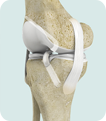
If you tear the anterior cruciate ligament in your knee, you may need to have reconstructive surgery. The anterior cruciate ligament (ACL) is a tough band of tissue joining the thigh bone to the shin bone at the knee joint. It runs diagonally through the inside of the knee and gives the knee joint stability. It also helps control the back-and-forth movement of the lower leg. ACL injuries Knee injuries can occur during sports such as skiing, tennis, squash, football and rugby. ACL injuries are the most common type of knee injury, accounting for around 40% of all sports injuries. You can tear your ACL if your lower leg extends forwards too much. It can also be torn if your knee and lower leg are twisted Common causes of an ACL injury include: landing incorrectly from a jump stopping suddenly changing direction suddenly having a collision, such as during a football tackle If the ACL is torn, your knee will become very unstable and lose its full range of movement. This can make it difficult to perform certain movements, such as turning on the spot. Some sports may be impossible to play Deciding to have surgery The decision to have knee surgery will depend on the extent of damage to your ACL and whether it’s affecting your quality of life. If your knee doesn’t feel unstable and you don’t have an active lifestyle, you may decide not to have ACL surgery. However, when deciding whether to have surgery it’s important to be aware that a delay could cause further damage to your knee. Before having surgery Before having ACL surgery, you may need to wait for any swelling to go down and the full range of movement to return to your knee. You may also need to wait until the muscles at the front of your thigh (quadriceps) and the back of your thigh (hamstrings) are as strong as possible. If you don’t have the full range of movement in your knee before having surgery, your recovery will be more difficult. It’s likely to take at least three weeks after the injury occurred for the full range of movement to return. You may be referred to a physiotherapist before having surgery. They’ll be able to help you regain the full range of movement in your knee. Your physio may show you some stretches you can do at home to help keep your leg flexible. They may also recommend low-impact exercise, such as swimming or cycling. These types of activities will help improve your muscle strength without placing too much weight on your knee. You should avoid any sports or activities that involve twisting, turning or jumping. Reconstructive ACL surgery A torn ACL can’t be repaired by stitching it back together. However, it can be reconstructed by grafting (attaching) new tissue onto it. The ACL can be reconstructed by removing what remains of the torn ligament and replacing it with a tendon from – for example, the hamstring or patellar tendon.…
read more